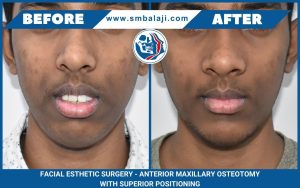Presentation of neurofibroma in this young man
A neurofibroma is a benign nerve sheath tumour of the peripheral nervous system. This is an inherited disorder of the nervous system. It adds to the bulk of the tissues and can be very disfiguring and distressing to the patient. This causes facial asymmetry.
Patient with neurofibroma presents for bulk reduction surgery
The patient here is a young man who developed this condition from birth. This had led to extensive right sided facial disfigurement of the patient. He had undergone surgeries elsewhere, which left behind residual scars. The disfigurement had reached a level where it was beginning to affect the patient’s day to day life. His parents conducted extensive Internet research for the best facial reconstruction surgeon. Their search had led them straight to our hospital.
Treatment plan explained to the patient
Prof SM Balaji examined the patient and ordered imaging studies. Studies revealed that the patient also needed reduction of the lateral orbital rim. It also revealed that the patient needed reduction of his chin and the maxillary bone. The patient also had ectropion of the left eye. Correction of the ectropion would be through lateral tarsorrhaphy. The patient and his parents agreed to the treatment plan.
Asymmetry of ears corrected with removal of excess tissue
Under general anesthesia, markings were first made on the excess ear tissue. Excision of the excess tissue would lead to symmetry of the patient’s ears. The excess tissue was first removed and the wounds were then closed with sutures.
Maxillary bulk reduction with mandibular chin reduction
Attention was then directed to the chin reduction procedure. The chin was next approached through a labial sulcus incision of the mandible. Dissection was then carried down to the chin. An osteotomy was then done at the lower border of the chin. The bone was next shaped and screwed back on the mandible. Incision was then closed with sutures. Maxillary vestibular incision was next done to access the hypertrophic right maxilla. Neurofibromatosis tissue was then excised and removed. The maxilla was then reduced until it was symmetrical with the left side. The incision was then closed with sutures.
Ectropion correction with lateral tarsorrhaphy
An incision was next made over the right eyebrow in the temporal region. Bulk reduction was then done with excision of excess tissue. The incision was then sutured. Attention was next turned to the ectropion correction. Markings were first made in the supraorbital region. This was then followed by excision of the excess tissue. The tissue was then sutured close. An incision was next made extending distal from the lateral canthus of the eye. A temporalis flap was then raised. Dissection was then carried down to the lateral orbital rim margin. The bone was then trimmed with a bur. Holes were then made in the bone for the sutures to pass for lateral tarsorrhaphy. This was to correct the patient’s ectropion. The sutures were then passed through the holes and tightened for ectropion correction. Excess tissues were then trimmed and incisions closed with sutures.
The patient tolerated the procedure well and recovered from general anesthesia.





